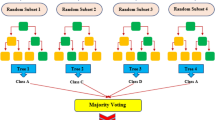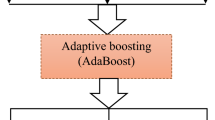Abstract
Solubility of CO2 in brine is one of the contributing trapping mechanisms by which the injected CO2 is sequestrated in aquifers. In the literature, the solubility data on low salinity range are scarce. Thus, in the current study, the CO2 solubility was experimentally obtained in the NaCl brines of low salinity (0–1.5 wt%) at temperature of 333–373 K and pressures up to 280 MPa through the potentiometric titration methods. The short-term, multistep ahead predictive models of aqueous solubility of carbon dioxide were created. The models were developed using a novel method based on the extreme learning machine (ELM). Estimation and prediction results of the ELM model were compared with the genetic programming (GP) and artificial neural networks (ANNs) models. The results revealed enhancement of the predictive accuracy and generalization capability through the ELM method in comparison with the GP and ANN. Moreover, the results indicate that the developed ELM models can be used with confidence for further work on formulating a novel model predictive strategy for the aqueous solubility of carbon dioxide. The experimental results hinted that the current algorithm can present good generalization performance in the majority of cases. Moreover, in comparison with the conventional well-known learning algorithms, it can learn thousands of times faster. In conclusion, it is conclusively found that application of the ELM is particularly promising as an alternative method to estimate the aqueous solubility of carbon dioxide.






Similar content being viewed by others
Change history
12 June 2020
The Editors-in-Chief of Environmental Earth Sciences are issuing an editorial expression of concern to alert readers that this article [1] shows evidence of substantial text overlap (most notably with the article cited [2]) and authorship manipulation. None of the authors responded to correspondence about this editorial expression of concern.
References
Annema A, Hoen K, Wallinga H (1994) Precision requirements for single-layer feedforward neural networks. In: Proceedings of the 4th international conference on microneuro, Turin, pp. 145–151
Azdarpour A, Asadullah M, Junin R, Manan M, Hamidi H, Mohammadian E (2014) Direct carbonation of red gypsum to produce solid carbonates. Fuel Process Technol 126:429–434
Azdarpour A, Asadullah M, Mohammadian E, Junin R, Hamidi H, Manan M, Daud ARM (2015) Mineral carbonation of red gypsum via pH-swing process: effect of CO 2 pressure on the efficiency and products characteristics. Chem Eng J 264:425–436
Babovic V, Keijzer M (2005) Rainfall-runoff modeling based on genetic programming. Encycl Hydrol Sci. doi:10.1002/0470848944.hsa017
Bachu S, Adams J (2003) Sequestration of CO2 in geological media in response to climate change: capacity of deep saline aquifers to sequester CO2 in solution. Energy Convers Manag 44(20):3151–3175
Chamkalani A, Nareh’ei MA, Chamkalani R, Zargari MH, Dehestani-Ardakani MR, Farzam M (2013) Soft computing method for prediction of CO2 corrosion in flow lines based on neural network approach. Chem Eng Commun 200(6):731–747
Chanda A, Akhand A, Manna S, Dutta S, Das I, Hazra S, Rao KH, Dadhwal VK (2014) Measuring daytime CO2 fluxes from the inter-tidal mangrove soils of Indian Sundarbans. Environ Earth Sci 72(2):417–427
Change IPOC (2007) Climate change 2007: synthesis report. IPCC, Geneva
De Lucia M, Bauer S, Beyer C, Kühn M, Nowak T, Pudlo D, Reitenbach V, Stadler S (2012) Modelling CO2-induced fluid–rock interactions in the Altensalzwedel gas reservoir. Part I: from experimental data to a reference geochemical model. Environ Earth Sci 67(2):563–572
Duan Z, Sun R (2003) An improved model calculating CO 2 solubility in pure water and aqueous NaCl solutions from 273 to 533 K and from 0 to 2000 bar. Chem Geol 193(3):257–271
Fuller R, Prevost J, Piri M (2006) Three‐phase equilibrium and partitioning calculations for CO2 sequestration in saline aquifers. J Geophys Res Solid Earth (1978–2012) 111(B6)
Godec ML, Kuuskraa VA, Dipietro P (2013) Opportunities for using anthropogenic CO2 for enhanced oil recovery and CO2 storage. Energy Fuels 27(8):4183–4189
Gonzalez-Nicieza C, Alvarez-Fernandez MI, Prendes-Gero MB, Pizarro-Garcia C, Oliva-Gonzalez A (2014) An experiment-based assessment of the feasibility of the CO2 geological storage in unexploited coal beds in northern Spain. Environ Earth Sci 71(8):3673–3684
Haroun AA, Shahaboddin S, Bardul AN, Dalibor P (2014) DFCL: dynamic fuzzy logic controller for intrusion detection. Facta Univ Ser Mech Eng 12(2):183–193
Heavysege RG (2002) Formation evaluation of fresh water shaly sands of the Malay Basin, offshore Malaysia. In: Transactions SPWLA 43rd annual logging symposium, 2002. Society of Petrophysicists and Well Log Analysts Houston, Texas
Huang G-B, Zhu QY, Siew C-K (2004) Extreme learning machine: a new learning scheme of feedforward neural networks. In: 2004 IEEE international proceedings joint conference on neural networks, vol 2, pp 985–990
Huang G-B, Zhu Q-Y, Siew C-K (2006a) Real-time learning capability of neural networks. IEEE Trans Neural Netw 17(4):863–878
Huang G-B, Zhu Q-Y, Siew C-K (2006b) Extreme learning machine: theory and applications. Neurocomputing 70(1):489–501
Huang G-B, Chen L, Siew C-K (2006c) Universal approximation using incremental constructive feedforward networks with random hidden nodes. IEEE Trans Neural Netw 17(4):879–892
Khu ST, Liong SY, Babovic V, Madsen H, Muttil N (2001) Genetic programming and its application in real-time runoff forecasting1. JAWRA 37(2):439–451
King JW, Friedrich JP (1990) Quantitative correlations between solute molecular structure and solubility in supercritical fluids. J Chromatogr A 517:449–458
Koschel D, Coxam J-Y, Rodier L, Majer V (2006) Enthalpy and solubility data of CO2 in water and NaCl (aq) at conditions of interest for geological sequestration. Fluid Phase Equilib 247(1):107–120
Koza J (1992) Genetic programming: on the programming of computers by natural selection. MIT Press, Cambridge
Li Z, Dong M, Li S, Dai L (2004) Densities and solubilities for binary systems of carbon dioxide + water and carbon dioxide + brine at 59 C and pressures to 29 MPa. J Chem Eng Data 49(4):1026–1031
Li Z, Dong M, Li S, Huang S (2006) CO2 sequestration in depleted oil and gas reservoirs—caprock characterization and storage capacity. Energy Convers Manag 47(11):1372–1382
Liang N-Y, Huang G-B, Saratchandran P, Sundararajan N (2006) A fast and accurate online sequential learning algorithm for feedforward networks. IEEE Trans Neural Netw 17(6):1411–1423
Liu Y, Hou M, Yang G, Han B (2011) Solubility of CO2 in aqueous solutions of NaCl, KCl, CaCl 2 and their mixed salts at different temperatures and pressures. J Supercrit Fluids 56(2):125–129
Liu H, Hou Z, Were P, Gou Y, Sun X (2014) Simulation of CO2 plume movement in multilayered saline formations through multilayer injection technology in the Ordos Basin, China. Environ Earth Sci 71(10):4447–4462
Liu H, Hou Z, Were P, Gou Y, Xiong L, Sun X (2015) Modelling CO2-brine-rock interactions in the Upper Paleozoic formations of Ordos Basin used for CO2 sequestration. Environ Earth Sci 73(5):2205–2222
Mahanty B, Kim S, Kim CG (2015) Dissolved and gaseous inorganic carbon sequestration using a close system cell-free ureolytic calcification process. Environ Earth Sci 73(4):1473–1477
Michael K, Golab A, Shulakova V, Ennis-King J, Allinson G, Sharma S, Aiken T (2010) Geological storage of CO 2 in saline aquifers—a review of the experience from existing storage operations. Int J Greenhouse Gas Control 4(4):659–667
Portier S, Rochelle C (2005) Modelling CO2 solubility in pure water and NaCl-type waters from 0 to 300 C and from 1 to 300 bar: application to the Utsira Formation at Sleipner. Chem Geol 217(3):187–199
Qi R, LaForce TC, Blunt MJ (2009) Design of carbon dioxide storage in aquifers. Int J Greenhouse Gas Control 3(2):195–205
Rosenqvist J, Kilpatrick AD, Yardley BW (2012) Solubility of carbon dioxide in aqueous fluids and mineral suspensions at 294 K and subcritical pressures. Appl Geochem 27(8):1610–1614
Sams W, Jikich S (2005) A neurosimulation tool for predicting performance in enhanced coalbed methane and CO2 sequestration projects. 2005. SPE Annual Technical Conference and Exhibition, 9–12 October, Dallas, Texas, SPE-97164-MS
Santha Sophiya M, Syed T (2013) Assessment of vulnerability to seawater intrusion and potential remediation measures for coastal aquifers: a case study from eastern India. Environ Earth Sci 70(3):1197–1209
Shahaboddin S, Kasra M, Hui-Ling C, Narayana SG, Dalibor P, Chao M (2015) Daily global solar radiation prediction from air temperatures using kernel extreme learning machine: a case study for Iran. J Atmospheric Solar-Terrestrial Phys 134:109–117. doi:10.1016/j.jastp.2015.09.014
Sheng H, Lv L, Liang B, Li C, Yuan B, Ye L, Yue H, Liu C, Wang Y, Zhu J, Xie H (2015) Aqueous carbonation of the potassium-depleted residue from potassium feldspar–CaCl2 calcination for CO2 fixation. Environ Earth Sci 73(11):6871–6879
Singh R, Balasundaram S (2007) Application of extreme learning machine method for time series analysis. Int J Intell Technol 2(4):256–262
Tsouris C, Szymcek P, Taboada-Serrano P, McCallum S, Brewer P, Peltzer E, Walz P, Adams E, Chow A, Johnson W (2007) Scaled-up ocean injection of CO2–hydrate composite particles. Energy Fuels 21(6):3300–3309
Vlastimir N, Shervin M, Shahaboddin S, Dalibor P, Sudheer C, Mohammad A (2016) Extreme learning machine approach for sensorless wind speed estimation. Mechatronics. doi:10.1016/j.mechatronics.2015.04.007
Wang X, Han M (2014) Online sequential extreme learning machine with kernels for nonstationary time series prediction. Neurocomputing 145:90–97
Wang J, Ryan D, Anthony EJ, Wigston A, Basava-Reddi L, Wildgust N (2012) The effect of impurities in oxyfuel flue gas on CO2 storage capacity. Int J Greenhouse Gas Control 11:158–162
Yu Q, Miche Y, Séverin E, Lendasse A (2014) Bankruptcy prediction using extreme learning machine and financial expertise. Neurocomputing 128:296–302
Zhang D, Gu L, Li S, Lian P, Tao J (2013) Interactions of supercritical CO2 with coal. Energy Fuels 27(1):387–393
Acknowledgments
The authors express their sincere thanks for the funding support received from the HIR-MOHE University of Malaya under Grant No. UM.C/HIR/MOHE/ENG/34.
Author information
Authors and Affiliations
Corresponding author
Rights and permissions
About this article
Cite this article
Mohammadian, E., Motamedi, S., Shamshirband, S. et al. Application of extreme learning machine for prediction of aqueous solubility of carbon dioxide. Environ Earth Sci 75, 215 (2016). https://doi.org/10.1007/s12665-015-4798-4
Received:
Accepted:
Published:
DOI: https://doi.org/10.1007/s12665-015-4798-4




